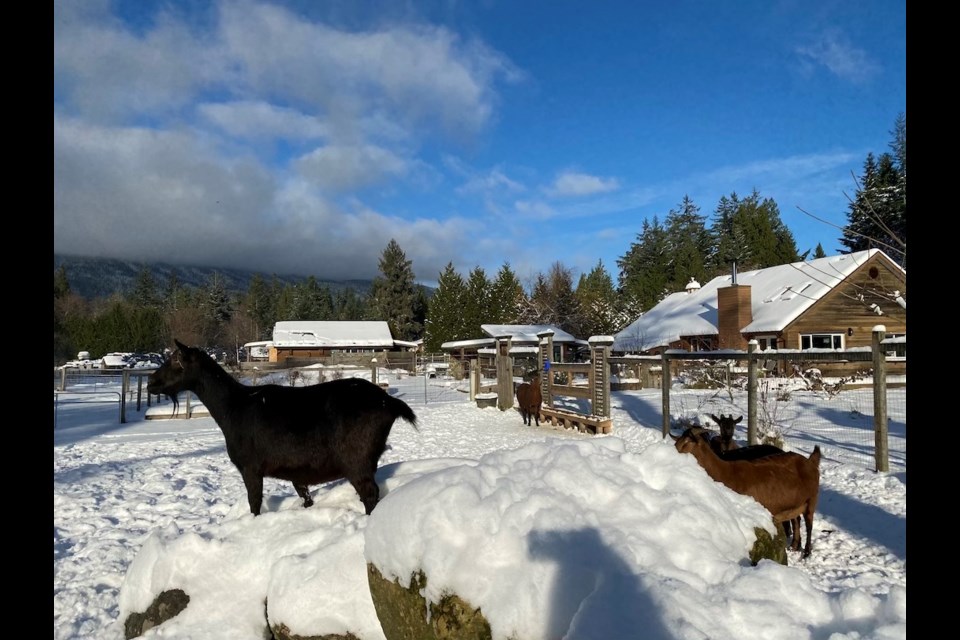After 2021 brought a deluge of unprecedented climate events – a drought, wildfires, heat dome, floods and heavy rains – farmers on the Sunshine Coast are now facing atypically cold winter conditions that are threatening livestock and crops.
The issues are interconnected, Raquel Kolof, the president of the Sunshine Coast Farmers’ Institute (SCFI) told Coast Reporter on the morning of Jan. 5, as more heavy snow was expected to fall that evening.
Less than two weeks ago, record-breaking winter weather hit the Sunshine Coast. Snow piled on top of greenhouses, collapsing the $10,000 to $20,000 structures and killing the crops inside. Water lines froze, making it difficult to get water to livestock. The state of some low-flow drip irrigation systems will only be known in the spring, once they are turned back on.
One benefit for livestock farmers is the cold weather sustained below zero degrees kills many pathogens in the soil and acts as a natural reset.
For crop farmers, the negative temperatures have caused crop loss of overwintering produce, such as kale and other greens.
Livestock farmers like Kolof, who owns Hough Heritage Farm in Gibsons, are also going through a “tremendous amount of bedding,” she said, because of the cold and the wetness. However, the straw and shavings used as bedding are now in limited supply, since the shavings factory in the Fraser Valley was flooded and the stock was lost.
Now, it’s a struggle to get bedding material, and product costs are increasing, Kolof said. The snow blanketing livestock farms also means they cannot use their pastures and the animals cannot forage the grounds. The farmers have to make up for the lost food by increasing hay feeding, which also helps keep the animals warm – but hay is difficult to come by these days.
“Everything’s interconnected,” Kolof said. “When the drought and fires happened, most of the hay farmers in B.C. lost their third cut of hay. That means there’s far less hay out there, the prices have risen. And now we’re having to feed extra hay because of the cold. So the bottom line is that farmers are having surging costs and decreased access to the materials they need to farm.”
In the past year, farmers have also started seeing commercial water fees, well licensing fees and farm insurance rates doubled. The unpredictable climate events add costs and decrease supplies, forcing farmers to increase their prices as well. Although the Sunshine Coast Regional District granted farmers a two-week exemption from Stage 4 water restrictions, Kolof said farmers need consistency in order to plan their growing seasons.
“But it’s very hard now for farmers to plan with all these unprecedented events that are occurring, not only at our doorstep, but in our province,” Kolof said.
Kolof has already taken in some animals other farms haven’t been able to keep, but she said she doesn’t know how much longer she’ll be able to sustain farming at the current prices and with decreased access to materials.
“I think what we’re seeing in the farming community here is death by 1,000 cuts,” she said.
“During the flooding, I went a week where I couldn’t find feed. And anyone who knows pigs, they experience hunger as pain. I cannot farm if I can’t feed my pigs. It is cruel to not feed them appropriately. And if there’s a week where I can’t find feed, I can’t tolerate that as an ethical farmer.”
Kolof said she’d like to see consistent support for small, rural farms from various levels of government similar to the support larger corporate food systems receive, as well as labour help to repair damage from climate events.
“Farming is becoming an elite sport, and it doesn’t bode well for local food security,” Kolof said. “The fact is, it’s not economically viable to farm because of all these added costs, barriers and regulation and unprecedented climate events. So I think we have to look at the bigger picture here and say, if we want a vibrant local food system, how can we support it as a community and as local government and provincial governments?”
Residents can help by buying local, buying seasonal and supporting local family businesses year-round. Sharing support on social media can also help spread the word, Kolof said.




